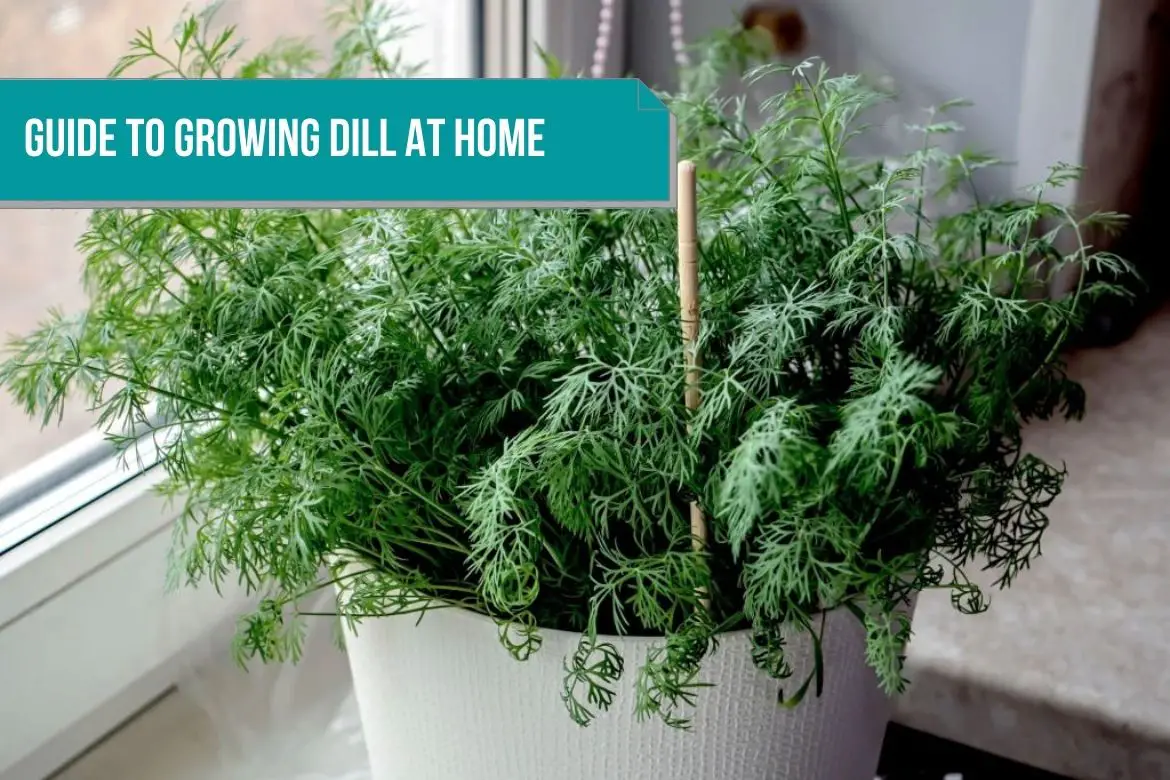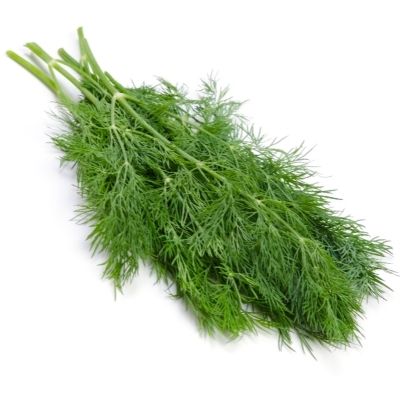
Botanical name : Anethum graveolens
Flavor Profile : Similar flavor as parsley mixed with celery, subtle anise and citrus undertone
Hardy, quickly growing herbaceous annual herb, dill (aka dill weed, or Anethum graveolens) is grown for its leaves and seeds. Dill’s two most common species are European (Anethum graveolens L) and Indian (Anethum sowa Roxb.).
The European dill is native to Europe and mainly grown in England, Germany, Romania, Turkey, the USA, and the former USSR. Whereas, Indian dill is native to south Asia.
It is regarded as one of the oldest cultivated herbs. Dill has a life cycle that lasts approximately two months.
The leaves, seeds and flowers of the dill plant are edible and can be found in Scandinavian, Russian, Mediterranean, and Middle Eastern cuisine.
In contrast to dill leaves, dill seed flavors are more intense and have a less licorice-like flavor. You can enhance the flavor of dill seeds by dry roasting them.
Dill is cultivated all over the world as a culinary and medicinal herb. Its seeds are often used as a flavoring agent. Various parts of the plant can be used to produce essential oils, which primarily consist of dill carvone, limonene, dill apiol, and α-phellendrene.
When fully mature, dill plants grow delicate, feathery leaves, and clusters of yellow flowers sprout from the top, mimicking the look and growth habits of their cousins parsley and caraway.
Varieties of Dill
- Bouquet
- Compatto
- Delikat
- Dukat
- Elephant
- Fernleaf
- Greensleeves
- Hera
- Herkules
- Long Island
- Mammoth Long Island
- Superdukat
- Teddy
- Vierling
Health benefits of Dill
Various common ailments have been successfully treated with dill without any side effects.
The antimicrobial properties of dill have long been known. In addition to preventing microbial infections throughout the body, it also prevents infections that can result from open wounds or small cuts on the skin.
Drill seed extract is effective in treating insomnia, cancer, diabetes, hypertension, bone density, and immunity, among others.
Due to its calcium content, dill is an essential component in protecting the body from osteoporosis and bone loss.
The dill plant has long been associated with cure diabetes and managing insulin levels.
Dill is a well-known carminative that is known to help prevent excessive gas.
Dill also helps in calming down hiccups which occur due to allergies, hyperactivity, or nervous disorders.
Essential oils of Dill are germicidal or bactericidal in nature. Hence, dill also cures diarrhea due to microbial infections and indigestion.
How to grow Dill indoors
You can grow dill both indoors and outdoors in containers. Make sure that the container is deep enough to accommodate the tall plant and its long roots.
Stakes may be needed to support the plants.
You can keep the container outside (windowsill or front porch) in case you live in a tropical climate. However, if you live at a place where it rains quite often or a chilly place, then keep the plant indoor in a controlled environment.
If you can control the temperature of the room, than you can grow dill all year round, provided the lighting conditions are met.
If you don’t take care of the plant, the first frost will kill the plant.
Plant size

3 feet (90 cm)
Container / pot Size

12 inches wide and Deep at least. A 5 gallon (18 liters approx) container is a good option.
Refer how to choose the right container for your indoor plants for more details.
Sunlight
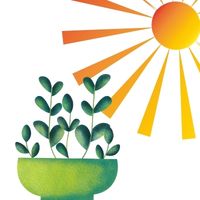
Full Sun. 6-5 hours of direct sunlight each day.
For best results in growing dill indoors, place the container near a large south facing window. Or you can place the container near east or west facing windows or windowsills. Placing under a skylight under direct sun is also a good option.
Refer Best locations and Light requirements for indoor plants for more details.
Soil

Well drained, light and rich in organic matter potting mix.
Dill thrive on a soil with pH range 5.8 to 6.5.
The plant can survive temperatures as ow as 25 degree Fahrenheit (-3 degree Celsius approx). However, avoid such low temperatures if you can.
You can mix compost in the potting mix in the ration of 50:50.
Please refer How to get the right potting mix for your container plant for more details.
Sowing
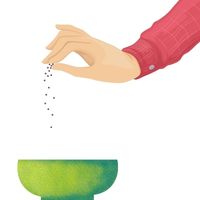
Sow 8 to 10 seeds in your growing container.
You can either Plant seeds 1/4th an inch deep in the potting mix or even just drop the seeds over the potting mix. Seedlings will grow in both the cases. In case you plan to keep the plant container outside, sow the seeds right after the last frost (April through May can be a good time to sow).
After 1 to 2 weeks you will start seeing seedlings. Don’t worry if they don’t look like dill initially. After 2-3 weeks you will see clear definitions in the dill plant.
Keep the soil moist at the time of sowing the dill seeds.
After about a month, dill will become 4-6 inches tall.
The roots of dill grow thick and strong, which is why it’s best to transplant only young plants with roots and soil together.
Quick tip: As dill loves moist soil, at the time of sowing you can cover the potting soil with wet paper towel. This will help in reducing the moisture loss specially in hot weather.
Watering
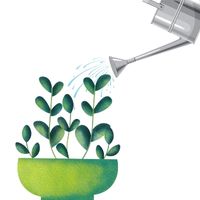
Water the dill plant regularly. Keep the soil moist but not over-saturated with water. Over water will lead to yellowing of leaf.
In case you see the leaves changing their color to yellow, hold back on watering for few days. It is highly probable that the leaves will recover after this.
Its crucial to have good drainage system in the container along with the good drainage qualities of the potting mix. Dill has deep roots. Ensuring good drainage of the container will prevent the deep roots from water stagnation.
Refer How to make drainage holes on potting container for more details.
Harvesting

The leaves of dill can be harvested after 6 weeks from seeding. However, The plant reaches maturity in 90 days.
Dill leaves have the most flavor when harvested just before flowering
Once the plant is 6 to 8 inches long, you can harvest the lower leaves of dill. This will also encourage the dill plant to grow taller.
Quick Tip : Harvesting dill early morning or late evening will give you the best flavor.
For harvesting seeds, cut the flowers after 2-3 weeks after bloom. Keep the flowers in a plastic or paper bag and let them dry. The seeds will fall in the bag after the flowers have dried.
Plant care
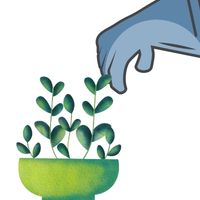
Dill plants have long stems. And because of the weight of the top leaves, they tend to topple over at the beginning stages of growth. To avoid this, support your dill plant with stakes (toothpicks also works well).
Protect the plant from strong winds.
Practice cutting the flowers so that the dill plant grows more foliage.
You can also plant new seeds of dill every 3 weeks or so. This will ensure a steady supply of dill.
SUBSTITUTES FOR DILL IN THE KITCHEN
- Fennel leaves
- Tarragon
How to keep Dill fresh
You can store fresh dill in the crisper section of you refrigerator for up to 14 days. Keep the dill leaves in an zip lock bag or air tight container.
Dill also responds well to freezing for storage purposes. This will significantly increase the storage time, up to 3-4 months.
Chop the dill and freeze it in ice tray.
Please refer to how to store herbs and spices for more details.
You can even store dill after drying it. this extends the shelf life to about 12 months. You can use food dehydrator or air drying method. For air drying, hand the stem upside down. You will know that the dill has dried when the leaves crumble to the touch. To be extra cautious, you can put the bouquet of dill in a paper bag before hanging it to dry.
How to use Dill in the kitchen
Dill is predominantly used as a garnish because of its flavor profile.
Herbs like dill are commonly used in cooking to enhance the taste of different dishes. Salmon, potatoes, and sauces based on yogurt are complemented by dill.
Dill leaves have a feathery texture, and a sprig of dill can add a noticeable flavor to a dish. Dill is also a tasty addition to salads, buttermilk and ranch dressings as its flavor is unique.
In case you are using dried dill instead of fresh dill in a recipe, you will have to use a bit more as dried dill has less intense flavor.
Dill will loose flavor in long cooking process. Hence, add it at the end of cooking process. However, dill seeds behave exactly the opposite. More you heat them more they release the aroma and flavor.
Be sure that the dill is completely dry before you chop it. Discard any thick stems beneath the leaves.
Dishes : Salads, dips, soup, sauces, marinades, dressings, bread, rice, curries.
Preparation : Used in whole or chopped or dried form.
Pairing Dill with food
Seasoning : Lemon juice, Garlic, mustard, balsamic vinegar, basil, horseradish, paprika, parsley, fennel, garlic, scallions, capers.
Fruits and Vegetables : Potatoes ( White Potato, Red Potato, Russet Potato, Purple Potato ), tomatoes, onions, jicama, carrots, beets, zucchini, asparagus, cucumber, celery.
Proteins : Fish and seafood, Eggs, goat, lamb, beef, lentils, pork, cheeses, beans, chicken.

